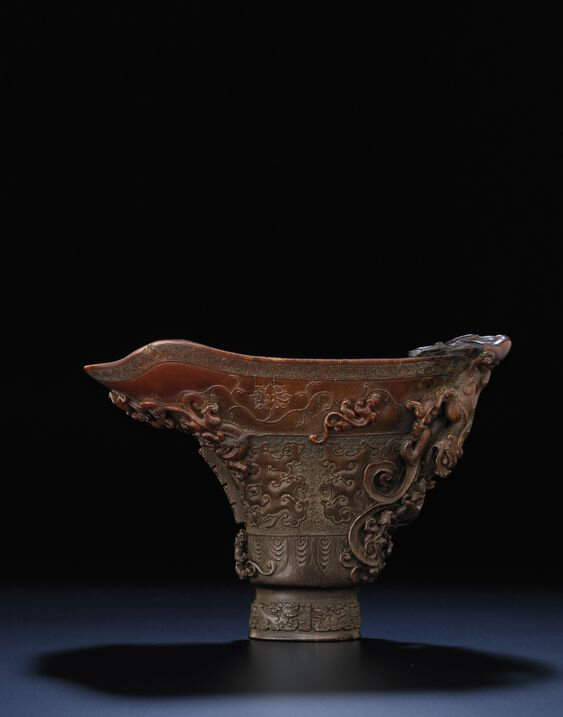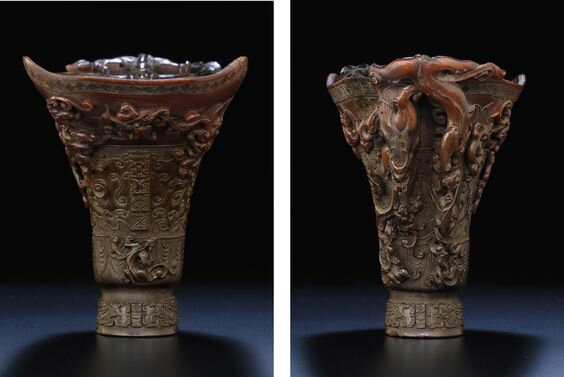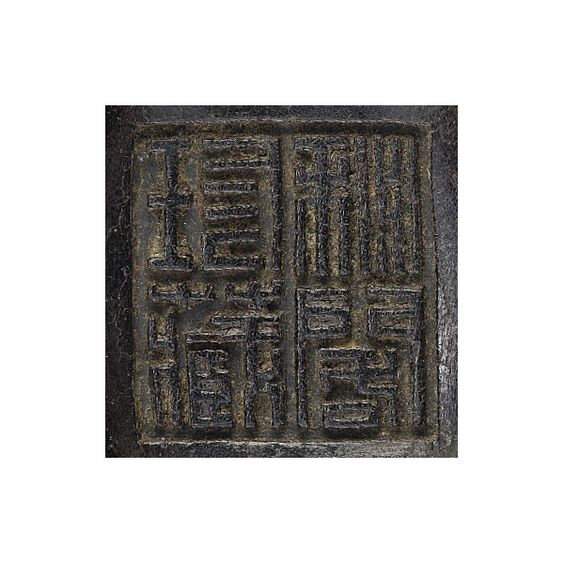1 juin 2011
A large and superbly carved archaistic 'chilong' libation cup, Ming dynasty, early 17th century, Mige Zhencang seal mark





Lot 3759. A large and superbly carved archaistic 'chilong' libation cup. Ming dynasty, early 17th century, mige zhencang four-character sealmark to the base; 7 1/2 in. (19 cm.) wide. Estimate HK$4,000,000 - HK$5,000,000 ($520,000 - $650,000). Price Realized HK$4,580,000 ($591,476). © Christie's Images Ltd. 2011
The generously sized cup with an elegantly proportioned tapering body, finely carved around the mid-section in varying levels of relief with archaistic taotie masks on a leiwen ground between lappet and lotus scroll bands, the foot encircled by a narrow band of confronted archaistic dragons separated by small flanges, the cup flanked by a ridged flange below the rim and a handle formed by a large pair of chilong, one in descent, the other in ascent with its head peering over the rim at a further chilong on the interior of the spout beneath the rim bordered by keyfret, with fourteen further smaller qilong playfully clambering around the sides of the cup, the material of a rich deep amber tone darkening to chestnut at the core.
Literature: Francois Leroy, Connaissance Des Arts, 'Les coupes en corne de rhinoceros', July 1978, no. 7
Jan Chapman, The Art of Rhinoceros Horn Carving in China, London, 1999, p. 134, no. 143 (mark)
Jan Chapman, The Art of Rhinoceros Horn Carving in China, London, 1999, p. 134, no. 143 (mark)
Note: The sealmark on the present cup is illustrated and discussed by Jan Chapman, The Art of Rhinoceros Horn Carving in China, London, 1999, p. 132-134, no. 143 where the author suggests that the mark is likely to be an unrecorded studio name or the name of the person who commissioned the cup. The author notes that approximately one in ten rhinoceros horn carving carry some sort of inscription and that archaistic cups such as the present example, invariably have the inscription or mark, incised to the base.
Christie's. Important Chinese Ceramics and Works of Art, 1 June 2011, Convention Hall
Publicité
Publicité
Commentaires

/https%3A%2F%2Fprofilepics.canalblog.com%2Fprofilepics%2F1%2F0%2F100183.jpg)
/https%3A%2F%2Fstorage.canalblog.com%2F03%2F02%2F119589%2F96711876_o.jpg)
/https%3A%2F%2Fstorage.canalblog.com%2F11%2F31%2F119589%2F94773502_o.jpg)
/https%3A%2F%2Fstorage.canalblog.com%2F20%2F83%2F119589%2F94772815_o.jpg)
/https%3A%2F%2Fstorage.canalblog.com%2F26%2F72%2F119589%2F75604929_o.jpg)
/https%3A%2F%2Fstorage.canalblog.com%2F59%2F60%2F119589%2F26458628_o.jpg)


/image%2F1371349%2F20240229%2Fob_bcf2a6_429481554-1625272224909457-79208462982.jpg)
/http%3A%2F%2Fstorage.canalblog.com%2F51%2F60%2F119589%2F126452602_o.jpg)
/http%3A%2F%2Fstorage.canalblog.com%2F35%2F48%2F119589%2F126270429_o.jpg)
/http%3A%2F%2Fstorage.canalblog.com%2F27%2F14%2F119589%2F126269685_o.jpg)